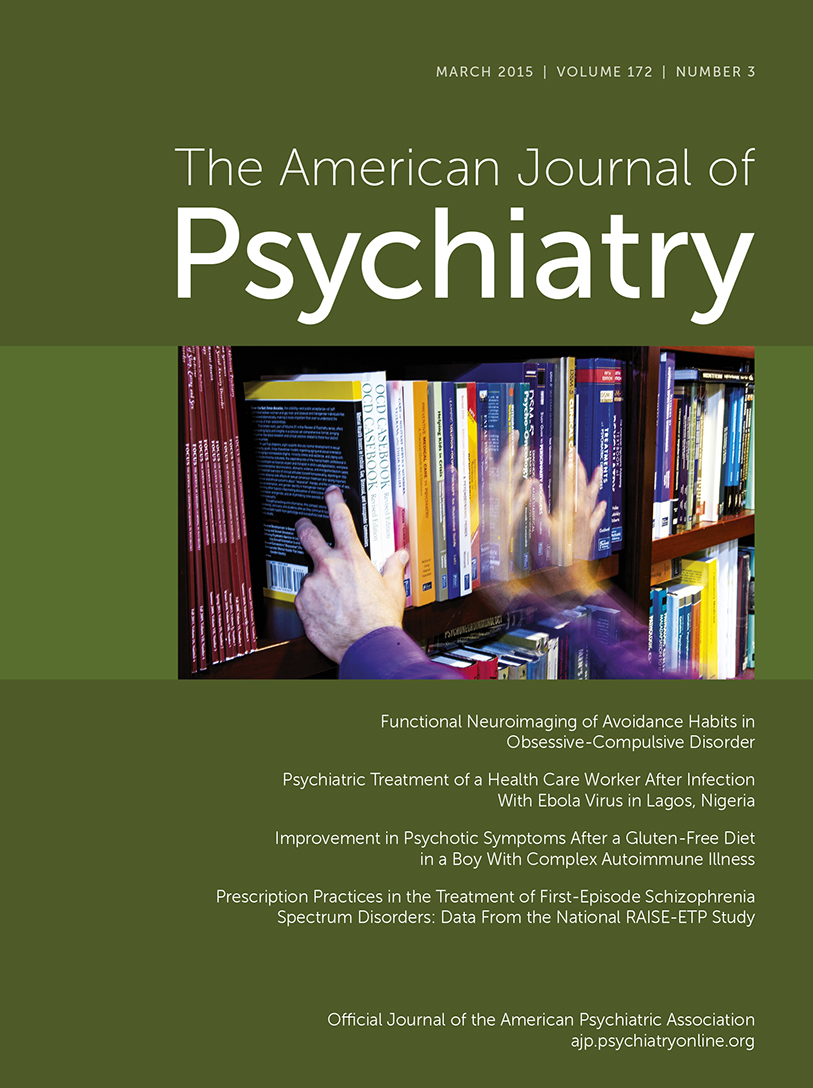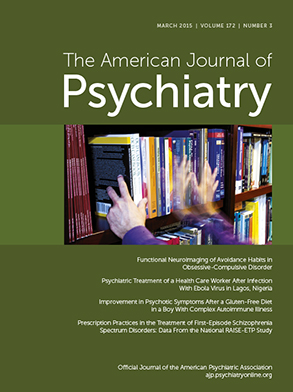Time present and time past
Are both perhaps present in time future,
And time future contained in time past. —T.S. Eliot
Good decisions reflect the past and improve the future. Trouble ensues when the rewards of the past conflict with the goals of the future. New goals often fail to override behaviors reinforced in the past, for instance, when patients with obsessive-compulsive disorder (OCD) try to stop the counting behavior that has been their main strategy to avoid aversive intrusions.
Decision-making theories that emphasize the existence of two decision systems working in parallel provide one fruitful multidisciplinary route for understanding the origin of this conflict (
1,
2): while habits reflect rewards of the past lengthily accumulated over multiple repetitions, goal-directed decisions capture aims based on the current, more malleable understanding of the world (
2). In certain disorders, such as those of impulsivity and compulsivity, an individual’s explicit aims appear to repeatedly fall prey to his or her engrained behaviors, suggesting an alteration in the adaptive tradeoff between prospective goals and retrospective habits (
3,
4).
In this issue of the
Journal, Gillan et al. (
5) add to an impressive catalog of studies on the
im-balance between habitual and goal-directed decisions in OCD. Roughly speaking, these studies assess how easily we overcome habits—established through repeated pursuit of an old goal—when a novel goal arises. Gillan et al. have previously shown that patients with OCD have a tendency to establish habits faster than comparison subjects when pursuing rewards (
6,
7) and, critically, also when avoiding punishments. Gillan et al. (
8) first explained to participants that two visual stimuli, say L and R, would be followed by shocks to their left or right wrist, respectively. A third stimulus, S, signaled safety. Participants could avoid the shock to the wrist threatened by the stimulus by pressing a foot-key with the respective foot (e.g., the left key for stimulus L). A training period in which participants repeatedly avoided the shocks predicted for both wrists was then followed by an instructed devaluation, where the shock electrode was demonstratively disconnected from the left wrist. Participants were explicitly instructed that they would no longer be shocked on the left wrist and that their only goal was to avoid the remaining shocks. Habitual avoidance was measured by the tendency to continue pressing the left foot-key when seeing the now
devalued stimulus L, despite knowing that this effort was unnecessary because the electrode had been disconnected. OCD patients were more than four times as likely to continue avoiding, indicating that they had established stronger habits than comparison subjects over the training period. There was no difference in the understanding of the devaluation, suggesting that avoidance was not driven by a goal-directed response to an overestimated shock probability. In their present study in this issue, Gillan et al. replicate these findings and extend them with data from functional imaging.
The behavioral replication is noteworthy, since it establishes faster habitization as one feature of OCD, suggesting that compulsions in OCD originate from the rapid transformation of goal-directed avoidance responses to obsessions into habits. Furthermore, habitization and autonomic measures of anxiety went hand-in-hand: patients who formed habits showed similar skin conductance responses for valued and devalued stimuli, suggesting that aspects of anxiety could be related to habit formation. And even though habits are components of everyday life, typically lacking a
compelling feel, they seemed to have a more urgent nature for OCD patients: the extent of habitization correlated with the participants’ self-reported urge to respond and also (more tentatively) with OCD symptom severity. OCD is thus one of the disorders accompanied by a shift from prospective goals toward retrospective habits, akin to addiction (
7,
9).
Possible origins of this shift are illuminated by the imaging results. Neurally, the goal-directed and habitual systems depend on different substrates (
10), and the authors focused their analysis on these. First, they found that the establishment of habits in the subgroup of patients continuing to respond to the devalued stimulus was accompanied by hyperactivity in the caudate. Patients who did not continue to respond after devaluation showed hypoactivity. Since there was also no overall difference between OCD patients and healthy comparison subjects, it is unclear whether caudate hyperactivity merely reflects the habitization differences or more general disease processes. Furthermore, animal lesion studies and human imaging studies have associated habit development with the putamen—the caudate is relatively more associated with goal-directed control over behavior (
10). Hence it is unclear how hyperactivity of the caudate, particularly in the absence of hyperactivity of the putamen, accounts for increased habitization. In conjunction with the confound between habitization and disease, the authors reasonably interpret the hyperactivity as possibly reflecting futile efforts to impose goal-directed behavior to overcome habits. The alternative, that maladaptive goals are the very source of the persistent responding, is hard to square with the lack of difference in understanding.
Second, Gillan et al. also report a neural difference between OCD patients and healthy comparison subjects: during the acquisition of avoidance behaviors prior to devaluation, OCD patients showed an initial hyperactivation of the orbitofrontal cortex that decreased over time, whereas in healthy comparison subjects, the orbitofrontal cortex activations increased over time. Orbitofrontal cortex neurons are known to represent stimulus value, particularly so in goal-directed scenarios (
11). An early hyperactivation followed by a gradual decline might be in keeping with a gradual transition from goal-directed to habitual decisions in OCD patients. However, this finding is complicated by a lack of correlate with habitization itself and does not quite match the hypothesis of futile goal-directed efforts in the devaluation phase.
Overall, the authors’ conclusion is that the shift toward habitization in OCD is a result of an impairment in goal-directed control. This is in agreement with the human goal-directed system appearing more malleable by state factors ranging from stress (
12) and dopamine (
13) to trait variables such as IQ (
14). To fully establish the suggestion that a shift toward bias is an endophenotype, it will be necessary to further disentangle and understand the antecedents of the tradeoff between goals and habits.
Computational accounts of the balance between the systems suggest either a competitive setup, in which the relative weight of each system depends on its respective reliability (
2), or a more cooperative interaction, in which the goal-directed system improves upon (
15) or even trains (
16) habits. The intact understanding of the task contingencies and the lack of activation in neural structures associated with uncertainty-based competition (
17) speak against the first option. Conversely, the initial orbitofrontal cortex hyperactivation makes the training of habits by internal repetitions within the goal-directed system a distinct possibility. An entirely different explanation for continued responding after devaluation is that sudden changes can be encoded as novel states, which accounts for a broad variety of learning effects (
18). A trait-like tendency to avoid generating new states—likely involving the orbitofrontal cortex (
19)—would lead to a failure to encode the change and not only explain continued responding after devaluation but also why extinction becomes more efficient with increasing symptom severity (
20) despite being overall impaired in OCD.
The further integration of clinical and computational approaches opens the door to a more quantitative understanding of the failure modes of the will in OCD. Clinically, the study by Gillan et al. matches the intuition that, for OCD patients, explanations alone do not suffice. Healing comes from repeated experience and the establishment of novel habits. This, though, is a long and tricky path because the habitual system has to lengthily recreate a novel history such as to align past experience with current goals.

